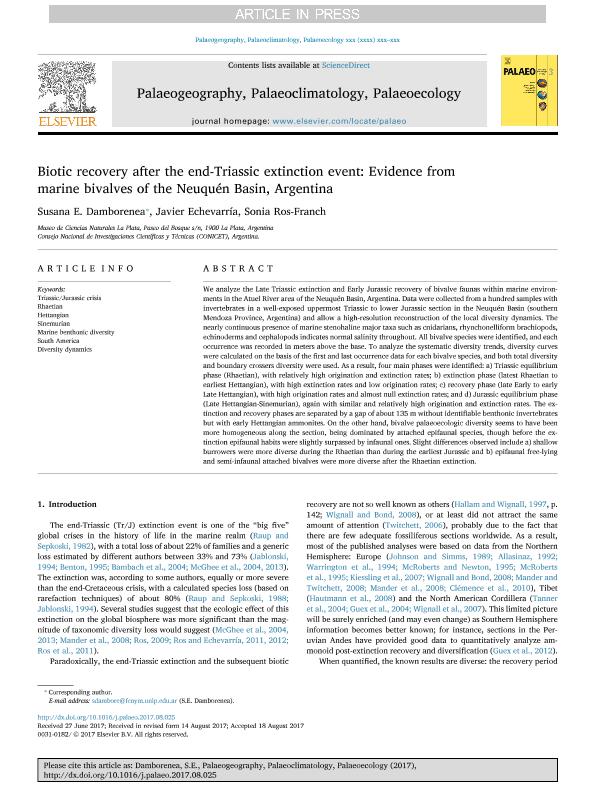Artículo
Biotic recovery after the end-Triassic extinction event: Evidence from marine bivalves of the Neuquén Basin, Argentina
Fecha de publicación:
12/2017
Editorial:
Elsevier Science
Revista:
Palaeogeography, Palaeoclimatology, Palaeoecology
ISSN:
0031-0182
Idioma:
Inglés
Tipo de recurso:
Artículo publicado
Clasificación temática:
Resumen
We analyze the Late Triassic extinction and Early Jurassic recovery of bivalve faunas within marine environments in the Atuel River area of the Neuquén Basin, Argentina. Data were collected from a hundred samples with invertebrates in a well-exposed uppermost Triassic to lower Jurassic section in the Neuquén Basin (southern Mendoza Province, Argentina) and allow a high-resolution reconstruction of the local diversity dynamics. The nearly continuous presence of marine stenohaline major taxa such as cnidarians, rhynchonelliform brachiopods, echinoderms and cephalopods indicates normal salinity throughout. All bivalve species were identified, and each occurrence was recorded in meters above the base. To analyze the systematic diversity trends, diversity curves were calculated on the basis of the first and last occurrence data for each bivalve species, and both total diversity and boundary crossers diversity were used. As a result, four main phases were identified: a) Triassic equilibrium phase (Rhaetian), with relatively high origination and extinction rates; b) extinction phase (latest Rhaetian to earliest Hettangian), with high extinction rates and low origination rates; c) recovery phase (late Early to early Late Hettangian), with high origination rates and almost null extinction rates; and d) Jurassic equilibrium phase (Late Hettangian-Sinemurian), again with similar and relatively high origination and extinction rates. The extinction and recovery phases are separated by a gap of about 135 m without identifiable benthonic invertebrates but with early Hettangian ammonites. On the other hand, bivalve palaeoecologic diversity seems to have been more homogeneous along the section, being dominated by attached epifaunal species, though before the extinction epifaunal habits were slightly surpassed by infaunal ones. Slight differences observed include a) shallow burrowers were more diverse during the Rhaetian than during the earliest Jurassic and b) epifaunal free-lying and semi-infaunal attached bivalves were more diverse after the Rhaetian extinction.
Archivos asociados
Licencia
Identificadores
Colecciones
Articulos(CCT - LA PLATA)
Articulos de CTRO.CIENTIFICO TECNOL.CONICET - LA PLATA
Articulos de CTRO.CIENTIFICO TECNOL.CONICET - LA PLATA
Citación
Damborenea, Susana Ester; Echevarría, Javier; Ros Franch, Sonia; Biotic recovery after the end-Triassic extinction event: Evidence from marine bivalves of the Neuquén Basin, Argentina; Elsevier Science; Palaeogeography, Palaeoclimatology, Palaeoecology; 487; 12-2017; 93-104
Compartir
Altmétricas




